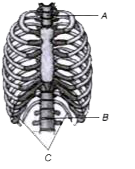What are critical constants? What are their significances?
Step-by-Step Solution:
1. Definition of Critical Constants:
Critical constants are specific properties of a substance, particularly gases, that define the conditions under which a gas can be liquefied. The three critical constants are:
- Critical Temperature (TC): The maximum temperature at which a gas can be liquefied, regardless of the pressure applied.
- Critical Pressure (PC): The minimum pressure required to liquefy a gas at its critical temperature.
- Critical Volume (VC): The volume occupied by one mole of a substance at its critical temperature and critical pressure.
2. Mathematical Representation:
The critical constants can be derived from Van der Waals constants (A and B):
- Critical Temperature (TC): TC=8A27Rb
- Critical Pressure (PC): PC=A27B2
- Critical Volume (VC): VC=3B
3. Significance of Critical Constants:
- Critical Temperature (TC): It indicates the maximum temperature at which a gas can be liquefied. Above this temperature, no amount of pressure will cause the gas to liquefy.
- Critical Pressure (PC): It is the maximum pressure that can be applied to a gas at its critical temperature to achieve liquefaction. If the pressure is below this value, the gas cannot be liquefied, even at the critical temperature.
- Critical Volume (VC): It represents the volume occupied by one mole of the gas at the critical point, which is essential for understanding the behavior of gases under different conditions.
Critical constants are specific properties of a substance, particularly gases, that define the conditions under which a gas can be liquefied. The three critical constants are:
- Critical Temperature (TC): The maximum temperature at which a gas can be liquefied, regardless of the pressure applied.
- Critical Pressure (PC): The minimum pressure required to liquefy a gas at its critical temperature.
- Critical Volume (VC): The volume occupied by one mole of a substance at its critical temperature and critical pressure.
The critical constants can be derived from Van der Waals constants (A and B):
- Critical Temperature (TC): TC=8A27Rb
- Critical Pressure (PC): PC=A27B2
- Critical Volume (VC): VC=3B
- Critical Temperature (TC): It indicates the maximum temperature at which a gas can be liquefied. Above this temperature, no amount of pressure will cause the gas to liquefy.
- Critical Pressure (PC): It is the maximum pressure that can be applied to a gas at its critical temperature to achieve liquefaction. If the pressure is below this value, the gas cannot be liquefied, even at the critical temperature.
- Critical Volume (VC): It represents the volume occupied by one mole of the gas at the critical point, which is essential for understanding the behavior of gases under different conditions.
Topper's Solved these Questions
- STATES OF MATTER : GASES AND LIQUIDSBOOK - MODERN PUBLICATIONCHAPTER - STATES OF MATTER : GASES AND LIQUIDSEXERCISE - Revision Exercises (Objective Questions)(Numerical Problems)
13 Videos
- STATES OF MATTER : GASES AND LIQUIDSBOOK - MODERN PUBLICATIONCHAPTER - STATES OF MATTER : GASES AND LIQUIDSEXERCISE - HIGHER ORDER THINKING SKILLS (ADVANCED LEVEL)
19 Videos
- STATES OF MATTER : GASES AND LIQUIDSBOOK - MODERN PUBLICATIONCHAPTER - STATES OF MATTER : GASES AND LIQUIDSEXERCISE - Revision Exercises (Objective Questions)(Short Answer Questions)
37 Videos
- SOME BASIC CONCEPTS OF CHEMISTRY BOOK - MODERN PUBLICATIONCHAPTER - SOME BASIC CONCEPTS OF CHEMISTRY EXERCISE - COMPETITION FILE (INTEGER TYPE AND NUMERICAL VALUE TYPE QUESTIONS)
10 Videos
- STRUCTURE OF ATOMBOOK - MODERN PUBLICATIONCHAPTER - STRUCTURE OF ATOMEXERCISE - Unit Practice Test
13 Videos
Similar Questions
What is critical point?
View Solution
What is the significance of C?
View SolutionWhat is critical concentration?
View SolutionWhat is critical concentration?
View SolutionWhat is the significance of MOET ?
View SolutionWhat is critical concentration ?
View SolutionWhat is significance of IUDs.
View SolutionWhat are chiasmata? State their significance.
View SolutionWhat is significance of BOD?
View SolutionWhat is the significance of meiosis?
View Solution
